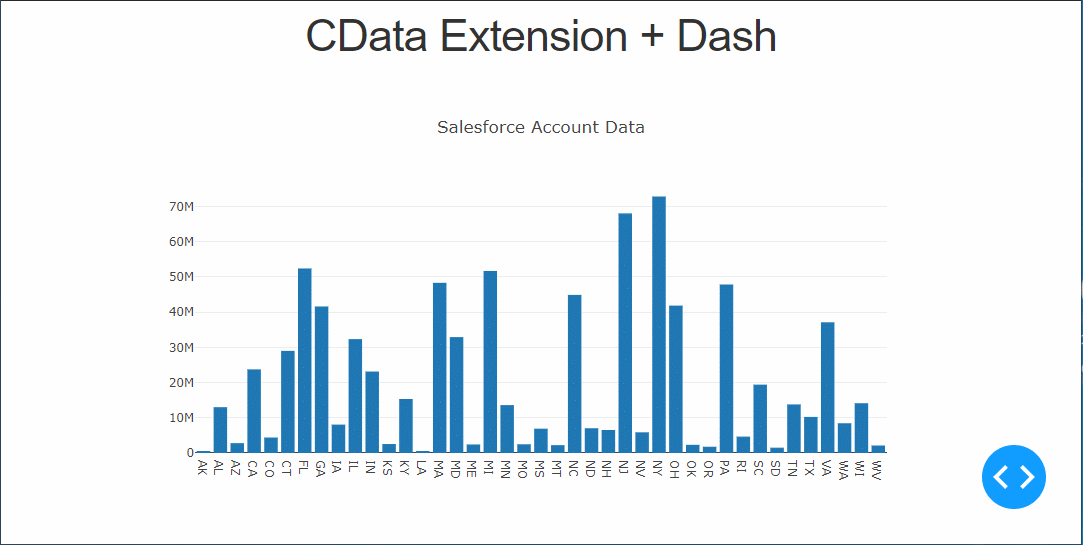Model Context Protocol (MCP) finally gives AI models a way to access the business data needed to make them really useful at work. CData MCP Servers have the depth and performance to make sure AI has access to all of the answers.
Try them now for free →Use Dash to Build to Web Apps on Snowflake Data
Create Python applications that use pandas and Dash to build Snowflake-connected web apps.
The rich ecosystem of Python modules lets you get to work quickly and integrate your systems more effectively. With the CData Python Connector for Snowflake, the pandas module, and the Dash framework, you can build Snowflake-connected web applications for Snowflake data. This article shows how to connect to Snowflake with the CData Connector and use pandas and Dash to build a simple web app for visualizing Snowflake data.
With built-in, optimized data processing, the CData Python Connector offers unmatched performance for interacting with live Snowflake data in Python. When you issue complex SQL queries from Snowflake, the driver pushes supported SQL operations, like filters and aggregations, directly to Snowflake and utilizes the embedded SQL engine to process unsupported operations client-side (often SQL functions and JOIN operations).
About Snowflake Data Integration
CData simplifies access and integration of live Snowflake data. Our customers leverage CData connectivity to:
- Reads and write Snowflake data quickly and efficiently.
- Dynamically obtain metadata for the specified Warehouse, Database, and Schema.
- Authenticate in a variety of ways, including OAuth, OKTA, Azure AD, Azure Managed Service Identity, PingFederate, private key, and more.
Many CData users use CData solutions to access Snowflake from their preferred tools and applications, and replicate data from their disparate systems into Snowflake for comprehensive warehousing and analytics.
For more information on integrating Snowflake with CData solutions, refer to our blog: https://www.cdata.com/blog/snowflake-integrations.
Getting Started
Connecting to Snowflake Data
Connecting to Snowflake data looks just like connecting to any relational data source. Create a connection string using the required connection properties. For this article, you will pass the connection string as a parameter to the create_engine function.
To connect to Snowflake:
- Set User and Password to your Snowflake credentials and set the AuthScheme property to PASSWORD or OKTA.
- Set URL to the URL of the Snowflake instance (i.e.: https://myaccount.snowflakecomputing.com).
- Set Warehouse to the Snowflake warehouse.
- (Optional) Set Account to your Snowflake account if your URL does not conform to the format above.
- (Optional) Set Database and Schema to restrict the tables and views exposed.
See the Getting Started guide in the CData driver documentation for more information.
After installing the CData Snowflake Connector, follow the procedure below to install the other required modules and start accessing Snowflake through Python objects.
Install Required Modules
Use the pip utility to install the required modules and frameworks:
pip install pandas pip install dash pip install dash-daq
Visualize Snowflake Data in Python
Once the required modules and frameworks are installed, we are ready to build our web app. Code snippets follow, but the full source code is available at the end of the article.
First, be sure to import the modules (including the CData Connector) with the following:
import os import dash import dash_core_components as dcc import dash_html_components as html import pandas as pd import cdata.snowflake as mod import plotly.graph_objs as go
You can now connect with a connection string. Use the connect function for the CData Snowflake Connector to create a connection for working with Snowflake data.
cnxn = mod.connect("User=Admin;Password=test123;Server=localhost;Database=Northwind;Warehouse=TestWarehouse;Account=Tester1;")
Execute SQL to Snowflake
Use the read_sql function from pandas to execute any SQL statement and store the result set in a DataFrame.
df = pd.read_sql("SELECT Id, ProductName FROM Products WHERE Id = '1'", cnxn)
Configure the Web App
With the query results stored in a DataFrame, we can begin configuring the web app, assigning a name, stylesheet, and title.
app_name = 'dash-snowflakeedataplot' external_stylesheets = ['https://codepen.io/chriddyp/pen/bWLwgP.css'] app = dash.Dash(__name__, external_stylesheets=external_stylesheets) app.title = 'CData + Dash'
Configure the Layout
The next step is to create a bar graph based on our Snowflake data and configure the app layout.
trace = go.Bar(x=df.Id, y=df.ProductName, name='Id')
app.layout = html.Div(children=[html.H1("CData Extension + Dash", style={'textAlign': 'center'}),
dcc.Graph(
id='example-graph',
figure={
'data': [trace],
'layout':
go.Layout(title='Snowflake Products Data', barmode='stack')
})
], className="container")
Set the App to Run
With the connection, app, and layout configured, we are ready to run the app. The last lines of Python code follow.
if __name__ == '__main__':
app.run_server(debug=True)
Now, use Python to run the web app and a browser to view the Snowflake data.
python snowflake-dash.py

Free Trial & More Information
Download a free, 30-day trial of the CData Python Connector for Snowflake to start building Python apps with connectivity to Snowflake data. Reach out to our Support Team if you have any questions.
Full Source Code
import os
import dash
import dash_core_components as dcc
import dash_html_components as html
import pandas as pd
import cdata.snowflake as mod
import plotly.graph_objs as go
cnxn = mod.connect("User=Admin;Password=test123;Server=localhost;Database=Northwind;Warehouse=TestWarehouse;Account=Tester1;")
df = pd.read_sql("SELECT Id, ProductName FROM Products WHERE Id = '1'", cnxn)
app_name = 'dash-snowflakedataplot'
external_stylesheets = ['https://codepen.io/chriddyp/pen/bWLwgP.css']
app = dash.Dash(__name__, external_stylesheets=external_stylesheets)
app.title = 'CData + Dash'
trace = go.Bar(x=df.Id, y=df.ProductName, name='Id')
app.layout = html.Div(children=[html.H1("CData Extension + Dash", style={'textAlign': 'center'}),
dcc.Graph(
id='example-graph',
figure={
'data': [trace],
'layout':
go.Layout(title='Snowflake Products Data', barmode='stack')
})
], className="container")
if __name__ == '__main__':
app.run_server(debug=True)

